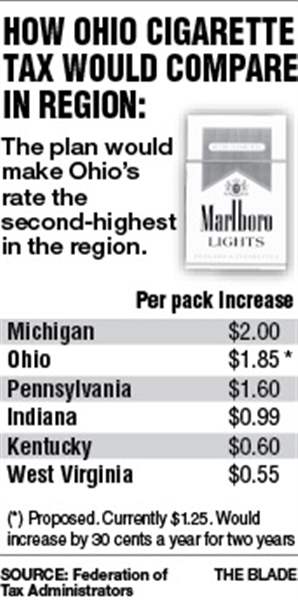
OHIO FUNDING
Governor proposes tax changes
Kasich eyes boosting cigarette, drilling fees
3/12/2014

COLUMBUS — To help offset his goal of dropping Ohio’s highest income tax rate below the symbolic threshold of 5 percent, Gov. John Kasich on Tuesday proposed hiking taxes on smokers, shale oil and natural gas drillers, and larger businesses.
His midway look at the two-year state budget also proposes to step up work-force development efforts, expand college credit opportunities for high school seniors, and steer more veterans toward employment and college degrees.
The tax cuts and hikes shake out to a net tax cut of $174 million in terms of total dollars. The plan includes a nearly $2.2 billion across-the-board cut in the personal income tax over three years plus an extra $453 million in tax breaks for lower-income Ohioans.
The latest plan would take Ohio’s top income tax rate from 5.3 percent to 4.88 percent over three years. This is in addition to efforts in the current budget to cut the income tax across the board by 10 percent for all Ohioans over three years and 50 percent on the first $250,000 earned by smaller businesses that pay the tax.
“We know what works — balanced budgets, tax cuts, better education and training, and a helping hand so everyone can benefit from a stronger Ohio,” the Republican governor said.
Faced with criticisms from Democrats that his tax policies favor the wealthy at the expense of the middle-class, the plan includes an expansion of the state’s new earned income tax credit that provides greater tax relief to lower-income Ohioans.
Like his broad sales tax base expansion proposed last year, Mr. Kasich likely will face pushback from fellow Republicans on some of the proposals, including the hike and expansion of the cigarette tax that would give the state the second-highest rate in the region.
The plan also would extend the cigarette tax rate to electronic cigarettes, which are subject only to the sales tax, as well as other lesser-taxed products such as cigars and chewing tobacco.
The rate for the broad commercial activities tax, imposed on larger businesses, would be raised from 0.26 percent of their gross receipts to 0.30 percent, its first increase since the CAT was created in 2005 to replace several other unpopular business taxes that were phased out.
The governor’s plan would increase taxation on shale oil and natural gas drilling to a flat 2.75 percent of the producers’ gross receipts while providing carve-outs to allow well producers to recover their start-up costs. That’s down from the 4 percent he last proposed.
The state now charges 3 cents per 1,000 cubic feet of natural gas and 20 cents per barrel of oil produced, which Mr. Kasich has blasted as unreasonably low in this new age of hydraulic fracturing or “fracking.”
The plan would raise the cigarette tax by 60 cents over two years — two installments of 30 cents — to ultimately give the state a tax rate of $1.85 per pack. Ohio would remain below the $2 imposed by Michigan but would leapfrog Pennsylvania at $1.60.
Anti-tobacco activists have urged lawmakers to hike the tax on cigarettes and to broaden its base, but some won’t support Mr. Kasich’s proposal.
“You need a tax in a sufficient amount to have a public-health effect,” said Shelly Kiser of the Ohio Lung Association. “You need at least 50 cents at a time or you do not encourage people to stop smoking. If it’s less than that, we don’t support it.”
The move won support from some other corners of the health community, however.
“While we understand the concerns by some that the tax is not high enough, we don’t want perfection to be the enemy of good,” said Melissa Wervey Arnold, executive director of the American Academy of Pediatrics’ Ohio Chapter.
The governor also has proposed to use some of the tobacco-settlement dollars that were recently released from a dispute with tobacco companies for renewed smoking prevention and enforcement of the state’s anti-smoking law.
Beth Wymer, executive director of the Ohio Wholesale Marketers Association, said the hike in the cigarette tax, and particularly on other tobacco products, will drive people in border counties to other states such as West Virginia, Kentucky, and Indiana with significantly lower rates. That’s a phenomenon that has benefited tobacco sellers in the Toledo area because of Michigan’s higher tax, she said.
“Less than 25 percent of Ohioans smoke and just 4.6 percent use smokeless tobacco,” she said. “A very small part of the Ohio population is going to be paying higher taxation so everybody else in Ohio gets a tax reduction.
“At the same time, 49 percent of smokers have annual household incomes less than $25,000, and 41 percent of those using other tobacco products have household incomes less than $25,000,” she said.
Studies have shown those households would see little from an across-the-board tax cut.
To make a point, the campaign of Mr. Kasich’s leading Democratic opponent in this year’s election, Cuyahoga County Executive Ed FitzGerald, sent pizzas to Statehouse reporters. The Blade canceled the order headed its way.
The move was made “to remind you that John Kasich’s income tax cut plan only amounts to a couple of pizzas for middle-class families,” said campaign spokesman Lauren Hitt. “However, if you fall within the top 1 percent, his tax cut could fund a round trip to Rome to eat pizza under the Colosseum. Not to say we don’t have great pizza here in Ohio, but that just doesn’t seem fair.”
Contact Jim Provance at: jprovance@theblade.com or 614-221-0496.